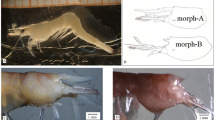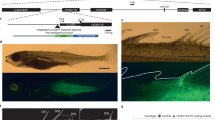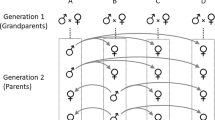Abstract
The developmental pathways of organisms are genetically adjusted to produce the characteristic morphology of the species regardless of variations in internal and external conditions during development. This ‘developmental buffering’, however, is not always precise. Bilateral characters of an organism are often asymmetric, that is, different in size, shape or number. Fluctuating asymmetry occurs when the difference between a character on the left and right sides of individuals is normally distributed about a mean of zero1. This type of asymmetry results from the inability of an organism to develop precisely along determined paths1,2 and can be used as a measure of developmental stability1,3–5. Increased developmental stability would be reflected by reduced amounts of fluctuating asymmetry. We have now examined the relationship between the amount of fluctuating asymmetry for five bilateral characters and heterozygosity at 13 polymorphic loci in a population of rainbow trout (Salmo gairdneri). Our results indicate a significant negative correlation between the proportion of heterozygous loci and the proportion of asymmetric characters. These data provide evidence that individuals with greater heterozygosity within a population have increased developmental stability.
This is a preview of subscription content, access via your institution
Access options
Subscribe to this journal
Receive 51 print issues and online access
$199.00 per year
only $3.90 per issue
Buy this article
- Purchase on Springer Link
- Instant access to full article PDF
Prices may be subject to local taxes which are calculated during checkout
Similar content being viewed by others
References
Van Valen, L. Evolution 16, 125–142 (1962).
Mason, L. G., Ehrlich, P. R. & Emmel, T. C. Evolution 21, 85–91 (1967).
Thoday, J. M. Heredity 12, 401–415 (1958).
Soulé, M. Am. Nat. 101, 141–160 (1967).
Felley, J. Copeia 1980, 18–29 (1980).
Lerner, I. M. Genetic Homeostasis (Oliver and Boyd, Edinburgh, 1954).
Robertson, F. W. & Reeve, E. C. R. Nature 170, 286 (1952).
Soulé, M. Evolution 33, 396–401 (1979).
Kat, P. W. Am. Nat. 119, 824–832 (1982).
Vrijenhoek, R. G. & Lerman, S. Evolution 36, 768–776 (1982).
Mitton, J. B. Nature 273, 661–662 (1978).
Eanes, W. F. Nature 276, 263–264 (1978).
Allendorf, F. W., Mitchell, N. J., Ryman, N. & Ståhl, G. Hereditas 86, 179–190 (1977).
Allendorf, F. W. & Phelps, S. R. Ecol. Bull. 34, 37–52 (1981).
Ohno, S. Animal Cytogenetics 4 (Gebruder Borntraeger, Berlin, 1974).
Bailey, G. S., Wilson, A. C., Halver, J. C. & Johnson, C. L. J. biol. Chem. 245, 5927–5940 (1970).
Paigen, K. in Physiological Genetics (ed. Scandalios, J. G.) 1–61 (Academic, New York, 1979).
Allendorf, F. W., Knudsen, K. L. & Phelps, S. R. Genetics 102, 259–268 (1982).
Sokal, R. R. & Rohlf, F. J. Biometry, 427–428 (Freeman, San Francisco, 1981).
Barlow, G. W. Syst. Zool. 10, 105–117 (1961).
Garside, E. T. J. Fish. Res. Bd Can. 23, 1537–1551 (1966).
Ali, M. Y. & Lindsey, C. C. Can. J. Zool. 52, 959–976 (1974).
Terner, C. Comp. Biochem. Physiol. 25 B, 989–1003 (1968).
Boulekbache, H. Am. Zool. 21, 377–389 (1981).
Author information
Authors and Affiliations
Rights and permissions
About this article
Cite this article
Leary, R., Allendorf, F. & Knudsen, K. Developmental stability and enzyme heterozygosity in rainbow trout. Nature 301, 71–72 (1983). https://doi.org/10.1038/301071a0
Received:
Accepted:
Issue Date:
DOI: https://doi.org/10.1038/301071a0
This article is cited by
-
Fluctuating asymmetry in the insular population of ayu, Plecoglossus altivelis ryukyuensis, estimating its genetic diversity at extinction
Ichthyological Research (2022)
-
Genomic consequences of intensive inbreeding in an isolated wolf population
Nature Ecology & Evolution (2017)
-
High levels of fluctuating asymmetry in isolated stickleback populations
BMC Evolutionary Biology (2012)
-
Fluctuating asymmetry in farmed Atlantic salmon (Salmo salar) juveniles: also a maternal matter?
Environmental Biology of Fishes (2008)
-
Fluctuating asymmetry and genetic variability in the roe deer (Capreolus capreolus): a test of the developmental stability hypothesis in mammals using neutral molecular markers
Heredity (2007)
Comments
By submitting a comment you agree to abide by our Terms and Community Guidelines. If you find something abusive or that does not comply with our terms or guidelines please flag it as inappropriate.



